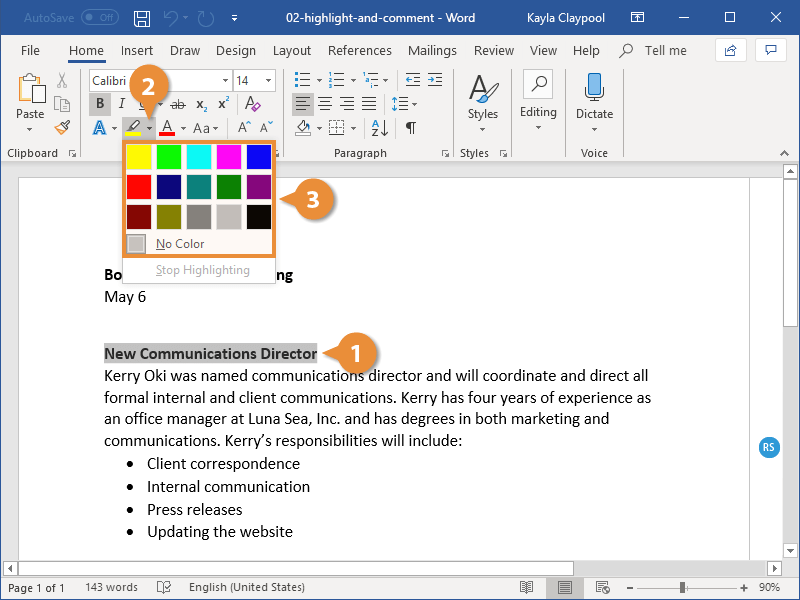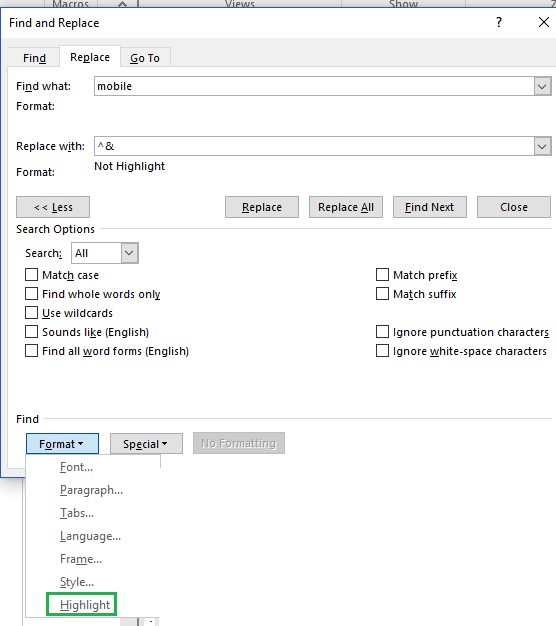
If this is a big concern for you, then I'd suggest defining styles for your shading, since you can always search for specific styles. One of the formatting attributes that you can search for is if the text is highlighted, but you cannot search for shading applied to text. On the Home tab, click the Text Highlight Color button list arrow. There is only one downside that I can find to using shading to highlight text, and that has to do with Find and Replace. Highlighting text adds a brightly-colored background to some selected text. Or, if you prefer, you can bypass macros altogether and simply create a character style that applies the desired shading to selected text.

With the macro in place, you can assign it to a shortcut key or to a toolbar button so you can apply your own "highlighting" whenever you want. BackgroundPatternColor = wdColorLightYellow ForegroundPatternColor = wdColorAutomatic The following macro applies pale yellow shading to the selected text. If you find a color you like to use a lot, you can create a macro that applies the shading to the selected text. Word then applies the selected color to the selected text, and it looks exactly like what you apply using the Highlight tool. (If you'd like to choose from more colors, click the More Colors button.) From the colors displayed, select the one you want to use.

(B) Add a comment to the highlighted word. (A) Click on any word in the list to highlight it. You can work with each comment in the list. Alternatively, click on the Comments Panel button at the lower left hand corner of the screen. The Shading tab of the Borders and Shading dialog box. Here’s how: Choose View>Navigation Panels>Comments. Make sure the Shading tab is displayed.Word displays the Borders and Shading dialog box. Choose Borders and Shading from the Format menu.(The colors appear to be hard-wired into Word.) You can, however, highlight text in a different way, if you prefer: by using shading. The colors used for highlighting cannot be changed beyond what is offered in the fifteen colors. Word allows you to pick any of fifteen different colors. Click on Formatting button to open the drop down. Click on the Find tab click inside the Find What textbox and click on More button. Press to go to the beginning of the document.

The default color for highlighting is yellow, but you can change the color if you click the down-arrow to the right of the Highlight tool on the Formatting toolbar. Make sure you have a document which contains many areas highlighted. For eg., "\" for text within the curly braces, so on.Word provides a highlighter tool that allows you to.well, "highlight" text, much as you would do with a highlighter pen on a printed document. You will have all the text in the document, within the parenthesis, highlighted! You can change "\(" and "\)" to other things as well. For the next part (to highlight), simply click on "Format" button and select "Highlight". Forum discussions with the word(s) highlight in the title. Note that you need to have "Use wildcards" checked. highlight - WordReference English dictionary, questions, discussion and forums. So basically it matches anything within the parenthesis. Next, "(*)" tells Word to find one or more words after the opening parenthesis, and finally "\)" the search pattern ends when it encounters closing parenthesis (requires an escape character). Here the first "\" is escape character, this tells Word to treat the next character "(", as-is i.e., find a opening parenthesis in the document. I decided to highlight all the authors using regular expressions. One problem: there were way too many citations! It was hard for me to distinguish authors and normal text.

They wanted me to look for the authors (citations) within the text and add correct reference in the “references” section. One example, I was recently given a 10 page document to edit and incorporate citations. Office 2013 offers robust regular expression matching, that will be very handy to do some basic stuff.


 0 kommentar(er)
0 kommentar(er)
